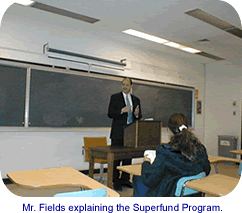The students of the EEM program enjoyed a valuable and informative experience during one of the classes (Policy Factors in Environmental and Energy Management - EMSE 220) offered by the program. Mr. Timothy Fields, former assistant administrator of the Environmental Protection Agency's (EPA) Office of Solid Waste and Emergency Response and current senior vice president of the Marasco Newton Group, gave a very interesting and enlightening speech on EPA's Superfund program. The following is a summary of the speech:
In the late 1970s, serious toxic waste contamination was discovered in various places, the Love Canal incident being one of the most well known. In response to these incidents, the Superfund law was enacted in 1980, with the initial intention of providing a $1.5 billion trust fund to clean-up sites over 5 years. The Superfund toxic waste cleanup program was initiated by EPA to implement this law and to protect citizens from the potential dangers of abandoned or uncontrolled hazardous waste sites. The Superfund program was envisioned as a short-term effort, but later environmental events demonstrated that it would last longer and that it would need considerably more funding. In 1986, the Superfund Amendments and Reauthorization Act (SARA) was enacted, supplying $8.5 billion over another 5 years. An "enforcement first" approach was adopted by EPA in 1989, in which the responsible party (for the contamination) would perform the cleanup first, and if this proved to be inadequate, would be provided with funding from the Superfund program. In 1995, the "Brownfields" program was established for sites that were not toxic and had low to moderate levels of contamination. This was succeeded by the Superfund Redevelopment Initiative, with the objective of converting waste sites into real estate for beneficial use.

The total annual Superfund expenditures of EPA are approximately $1.4 billion. Most of the expenditures for the Superfund program are towards the remedial program (40.5%). This is followed by program staff, management and support (21.2%) and the removal/emergency response program (20.7%). Site assessment comprises the smallest portion of Superfund expenditures (3.8%).
The removal/emergency response program has conducted approximately 6,400 removals to date, generally costing less than $2 million, and being completed in less than a year. This program is aimed at emergencies that states do not have enough capacity to deal with.
About 43,790 potential hazardous waste sites have been assessed under the Superfund site assessment program. Most (75%) of these sites have been removed from the Superfund inventory to encourage redevelopment, and the remaining 25% are active sites, with some on the National Priorities List (NPL). The focus of the Superfund remedial program has been the NPL sites. For these sites, the construction has been completed for a little over half (55%), with 70% of these pending deletion and the rest already deleted from the list. However, an additional 30 to 40 new sites are being added to the NPL each year. The average cleanup cost is about $25 million, and reaching from NPL listing to construction completion takes around 10 years.
The major Superfund policy issues for the future can be summarized in 7 points:
· How to pay for the cost of cleanup? (Superfund is funded by taxes applied to oil/gas companies and manufacturers. However, taxes expired in 1995, so there is the question of whether they will be reinstated).
· The future of the NPL (number of sites are continuously increasing; some sites have become 'mega-sites').
· Impact of terrorism on Superfund resources, priorities and achievements.
· Role of states in the implementation of the program.
· Post-construction activities (5-year reviews, institutional controls, deletions).
· Re-use of Superfund site properties for different purposes.
· Needed changes to legislation for the Superfund program (pending issues of small businesses, liability, etc.).


